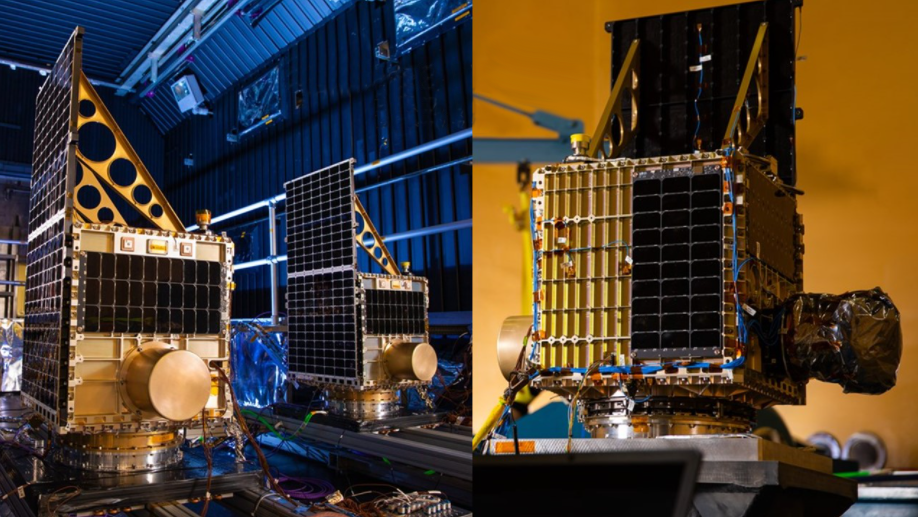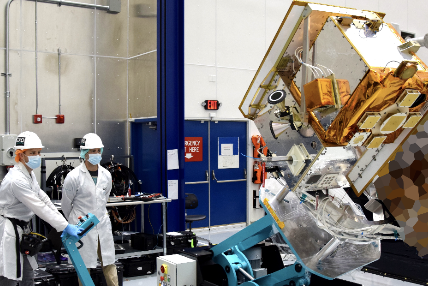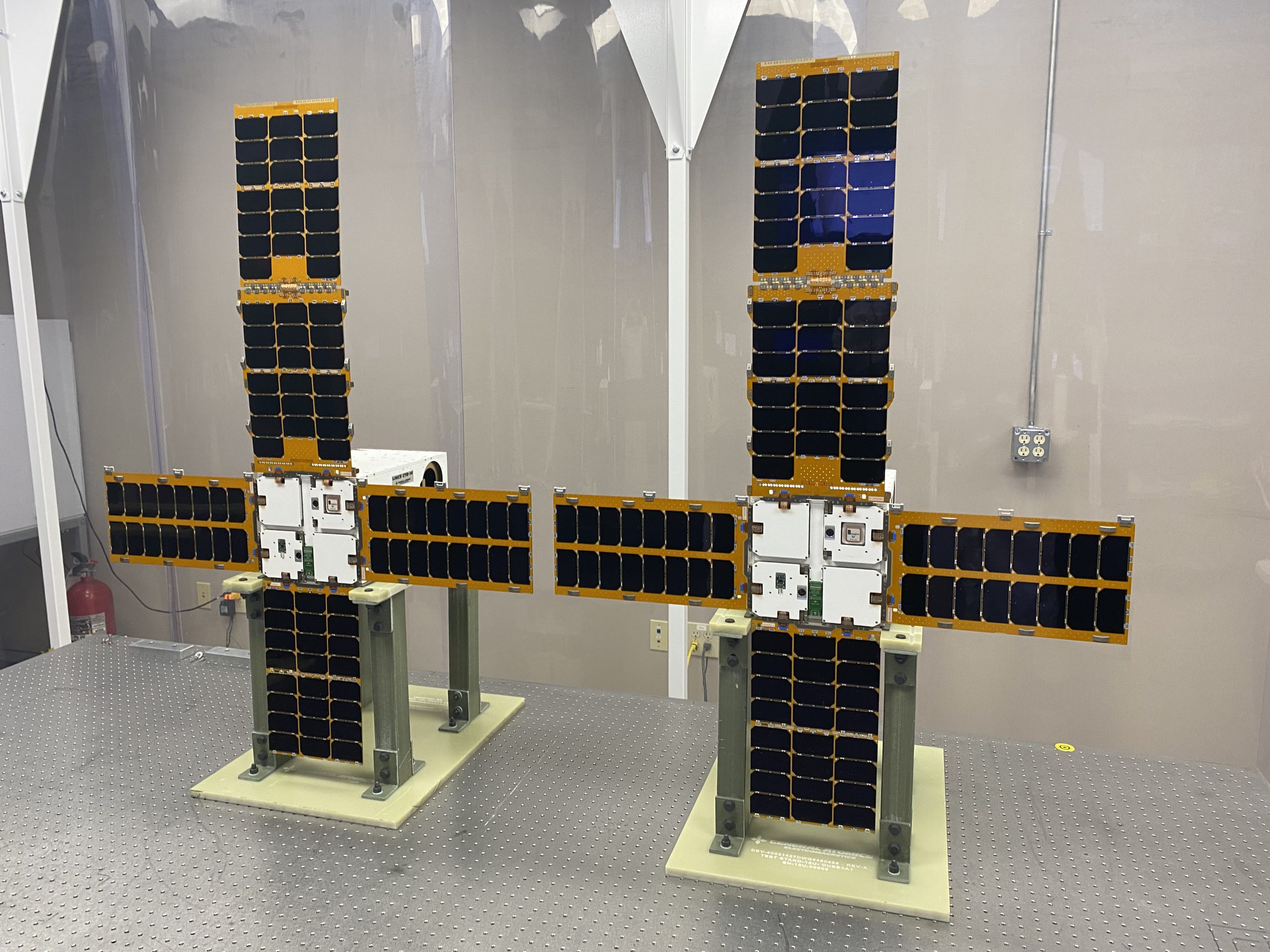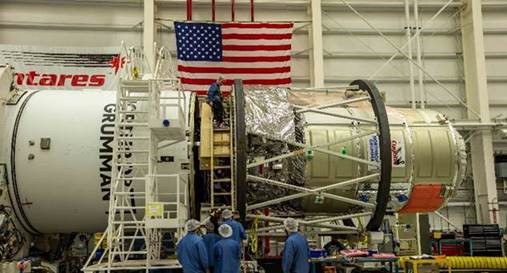On Orbit captures the current and past SDA efforts that have been launched into low Earth orbit. SDA continues to push the boundaries of next-generation space capabilities and what we put on orbit is the leading edge. As an agency, we accept a higher level of risk, employ novel business models, and move to develop and field capabilities more quickly than many other "traditional" government agencies and nowhere is that more apparent than what we have on orbit.

Tranche 1 Experimentation and Demonstration System (T1DES)
- Tranche 1 Experimentation and Demonstration System (T1DES) is comprised of 12 risk reduction satellites the that will demonstrate secure connectivity to warfighter platforms to support integration of capabilities like targeting, and warning and tracking of advanced missile threats.
- The satellites will support the Proliferated Warfighter Space Architecture (PWSA) Tranche 1 Transport Layer (T1TL) constellation with demonstration and experimentation of tactical satellite communication (TACSATCOM) and Integrated Broadcast Service (IBS) capabilities from low Earth orbit.
- SDA signed an agreement with York Space Systems in September 2022 for development, manufacturing, test, launch integration, and deployment of the 12 T1DES space vehicles and mission-enabling ground systems. The remaining T1DES space vehicles are expected to launch in fiscal year 2026.

T1DES Proto
- The first of 12 T1DES satellites launched on SpaceX’s Transporter-14 from Vandenberg Space Force Base, California, on June 23, 2025.
- This pathfinder satellite is referred to as T1DES Proto (for “prototype”), or by York’s program name, Dragoon.
- This launch represented accelerated delivery of the first T1DES space vehicle, on orbit four months ahead of the original baseline schedule.
Tranche 0
(Warfighter Immersion Tranche)
Tranche 0, the warfighter immersion tranche, demonstrates the feasibility of a proliferated architecture in cost, schedule, and scalability toward necessary performance for beyond line of sight targeting and advanced missile warning and tracking.
- 28 Tranche 0 space vehicles (SVs)- 20 Transport Layer SVs and 8 Tracking Layer SVs
- 2 commercially acquired SpaceX F9R (reusable) rocket launched from Vandenberg Space Force Base, Space Launch Complex (SLC) 4 East, for the first two launches in April and September 2023.
- The final Tranche 0 launch of four Tracking Layer SVs is a joint National Security Space Launch with the Missile Defense Agency's Hypersonic and Ballistic Tracking Space Sensor satellites out of Cape Canaveral Space Force Station, Florida in February 2023.

- The first group of Proliferated Warfighter Space Architecture (PWSA) satellites launched four years after standing up the agency and just over two years after awarding contracts to build these satellites.
- Cost is approximately $15 million per Transport SV.
SDA delivered Tranche 0 demonstration space vehicles on orbit beginning in 2023.
- Demonstrated the low latency data transport and missile warning/tracking capabilities of the PWSA and enables the warfighter to integrate PWSA capabilities into their planning for future exercises and operations (warfighter immersion).
- Achieved "first light" from SDA's initial Tracking Layer demo SVs in June 2023.
- Accomplished the first-ever Link16 radio network connection to and from space in November 2023.
- Additional warfighter immersion opportunities will take place before Tranche 1 begins to launch in late 2024.
Tranche 0 consists of a total of 28 optically-connected SVs:
- Transport: 20 SVs, which form the mesh satellite communications network. These SVs are deployed in two configurations:
-
-
- Group A (SVA): 13 mesh node SVs equipped with two optical communications terminals (OCTs) each & radio frequency (RF) receive/transmit capability.
- Group B (SVB): 7 SVs, with SVA configuration, plus tactical data link (TDL) receive/transmit capability.
-
-
- 1 T0 Transport Layer SV remains on the ground to serve as a testbed for software and compatibility with future Tranches.
- Tracking: 8 SVs equipped with the wide field of view (WFOV) sensor payload and two OCTs each.
- The majority of the space vehicles are distributed in two orbital planes; Inclination: 80°; Altitude: 1000km
DoD Press Release Announces Successful Launch of SDA Tranche 0 Satellites (April 2, 2023)

LINCS Overview
The Laser Interconnect and Networking Communication System (LINCS) program is an experiment in partnership with General Atomics. The two LINCS space vehicles will test space-to-space, space-to-air, and space-to-ground optical communication terminals. Initial goals for LINCS include:
- Evaluation of pointing, acquisition, and tracking algorithms
- Characterization of transfer rates and bit-error rates
- Evaluation of optical link performance both space-to-space, space-to-ground, and space-to-air.
- Implementation of a pod-mounted OCT capability for Low Probability of Intercept/Low Probability of Detection (LPI/LPD) evaluation.
Successful testing of LINCS is expected to bring first of its kind capabilities for LPI/LPD and continued evolution of technology in the area of OCT.

PIRPL Overview
Prototype Infrared Payload (PIRPL) is a medium field-of-view, multi-spectral infrared imager developed in partnership with the Missile Defense Agency and Northrop Grumman. The experiment will launch on Cygnus resupply mission NG-16 to the International Space Station (ISS), where it will undergo commissioning and initial data collection while berthed with the ISS. After the berthed mission completes, a free-flyer phase is planned in which PIRPL will perform additional data collections from an orbit above the ISS. PIRPL's primary objective is to collect representative infrared (IR) background images of the Earth and its atmosphere in multiple wavelengths. PIRPL data will enable improvement of existing IR scene models and development of advanced image processing capabilities. PIRPL data will span several infrared wavebands in the shortwave and midwave IR range that can also support weather and environmental monitoring missions in the future. Successful imagery from PIRPL may inform future SDA tranche evolution.
Mandrake II Overview
Mandrake II is an optical communication terminal (OCT) experiment in partnership with the Air Force Research Laboratory and the Defense Advanced Research Projects Agency. The two space vehicles are a primary contract with SEAKR and specifically with OCTs from SA Photonics. The experiment will test optical links at increasing ranges with an expected maximum distance of 2400 kilometers, based on orbital limitations. Initial goals for Mandrake II include:
- Evaluation of pointing, acquisition, and tracking algorithms
- Characterization of transfer rates and bit-error rates
- Evaluation of optical link performance both space-to-space and space-to-ground.
Successful testing of Mandrake II is expected to inform design modification and updates for future OCTs and provide risk mitigation for future tranche evolution.

POET Overview
Prototype On-Orbit Experimental Testbed (POET) is a Space Development Agency (SDA) Scientific Systems Company flying on a Loft Orbital YAM-3 spacecraft. POET will provide an on-orbit Custody Layer data fusion application that will reside within an overarching Battle Management Command, Control, and Communications (BMC3) software system. Initial objectives:
- Demonstration of an Automatic Target Recognition (ATR) algorithm with an Electro-optical sensor on board the Loft Orbital spacecraft bus
- Accommodation of 3rd party developed algorithms for fusion of data from multiple remote sensing sources
- Early experience with the spacecraft's CFC-400 processor's finite size, weight, and power
- Early orbital testing for future Custody Layer mission applications
- Battle Management Command, Control, and Communication (BMC3) insights and test opportunities

